Opinions expressed by Entrepreneur contributors are their own.
Starting your own local floral shop is an excellent way to combine your love of flowers with your love of community, especially if you have a flair for design and aesthetics. While floral design can be learned through trial and error, there are some tried-and-true steps that can help guide you in the right direction. This step-by-step guide will walk you through every aspect of starting a local florist shop, from finding your ideal location to choosing inventory, hiring employees and marketing to your customers.
Location
If you want to start your own floral business, it’s important to choose an appropriate location. Figure out which stores in your area are doing better than others, and consider opening up a shop in that location. You can often rent out a space or set up your own store; figure out what will work best for you, but make sure that there is enough foot traffic at that location. By choosing a high-traffic spot, you’ll be able to draw people in.
Related: 9 Tips to Market Your Floral Shop Successfully
Legalities
Every state and municipality has its own rules for starting a business. Consult with your city, county or state governments to determine what permits you’ll need and what you’ll have to do to comply with regulations and get them. You may also want to consult with an attorney about liability issues, if applicable.
Marketing
Flower delivery in the USA is becoming an increasingly popular option for consumers. Online flower shops make it possible to sell flowers delivered on-demand, even at busy times like Valentine’s Day and Mother’s Day. This can be highly lucrative for businesses looking to get into online flower sales. Getting started as an online florist is easier than you might think, especially if you already have an established business that delivers locally or has some kind of market presence and good reputation.
Operating cost
Estimate your operating costs by tallying up your monthly expenses. This includes any rent or mortgage payments, utilities, etc. Multiply that total by 12 to arrive at your annual operating cost (annual expense). You’ll need to know what your annual operating cost is to start estimating how much revenue you’ll need in order to break even or make a profit. Again, it’s best to use averages and ballpark numbers when you can here.
Related: How Slowing Down Saved This Flower Startup From Wilting
Equipment
Buying equipment is one of your primary expenses, so you’ll want to think it through carefully. Here are some questions to consider as you put together your equipment list: What type of flowers and plants will I be growing? If they are high-maintenance plants, you may need more support equipment. How large is my space? Where will everything go in my shop? Will I grow inside or outside? How much do I plan on expanding over time?
Employee costs
In many cases, you’ll need to hire employees to help with your business, whether it be to drive flowers from a distribution center or work with customers inside the flower shop. If you plan on hiring employees, make sure you take into account all of their associated costs when determining your budget for getting started. In addition to wages and any health benefits or other perks that may apply, it’s important to consider such overhead as worker’s compensation insurance and payroll taxes. Of course, if you have plans for operating a home business without employees, these costs won’t apply to you — but they might come up when running other types of retail operations.
Supplies and packaging
The supplies you’ll need to launch your local flower shop include a computer, floral designer software, online order forms, business cards, flyers and (of course) flowers. Most florists purchase their flowers through wholesalers who specialize in same-day flower delivery to local businesses. It’s helpful to know how many bouquets you’ll need each week when determining how much inventory to buy.
Related: Want to Run a Flower Shop? What You’ll Need — and What You Won’t.
Invest in a POS software
When you run your own business, you’re bound to have to deal with an insane amount of paperwork. When it comes to handling sales, inventory and payroll for a brick-and-mortar shop, pen and paper won’t cut it. If you plan on accepting credit cards or checks in exchange for your goods, invest in a point of sale (POS) system like Hana Florist POS — they offer great functionality and integrate seamlessly with accounting software.
Start small and build. If you can only provide flower delivery in the USA in your immediate neighborhood, then do so. Then add online ordering to your website. As soon as you’re ready, widen your delivery area, hire more drivers and expand your product line.
At each step of development — before you find yourself in over your head — step back, evaluate and re-evaluate until you have time to devote to a more advanced business plan. All the best!
Credit: Source link



